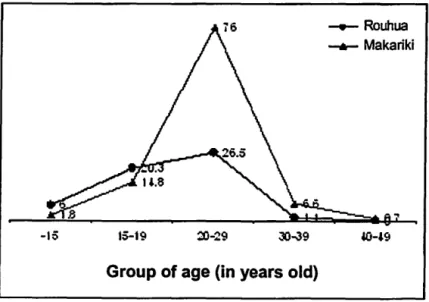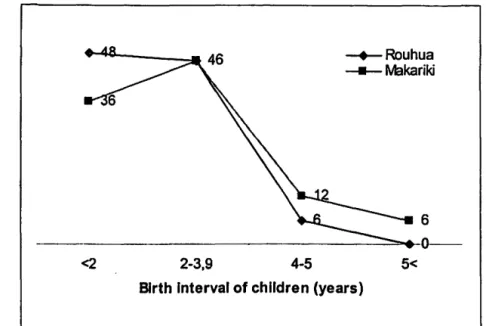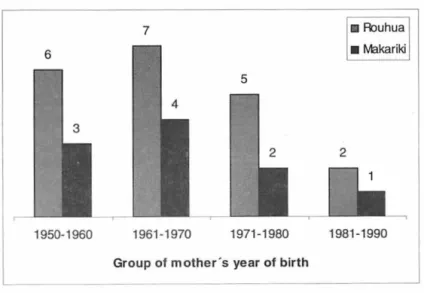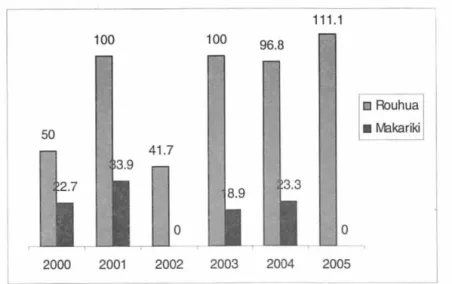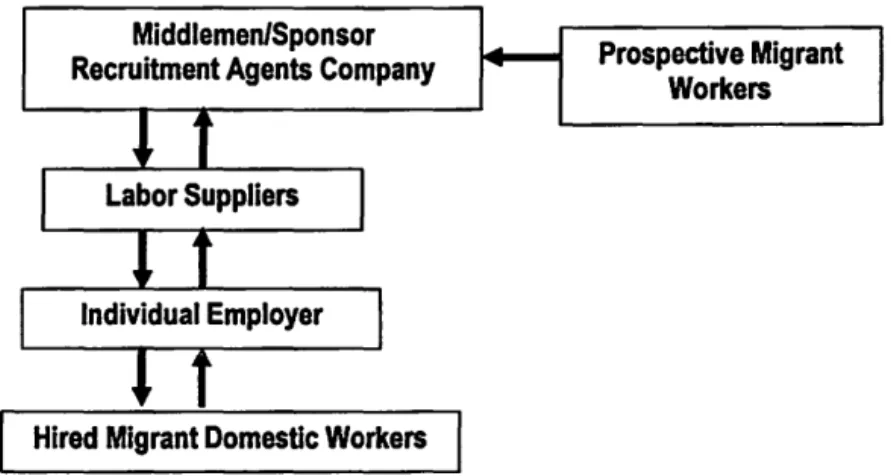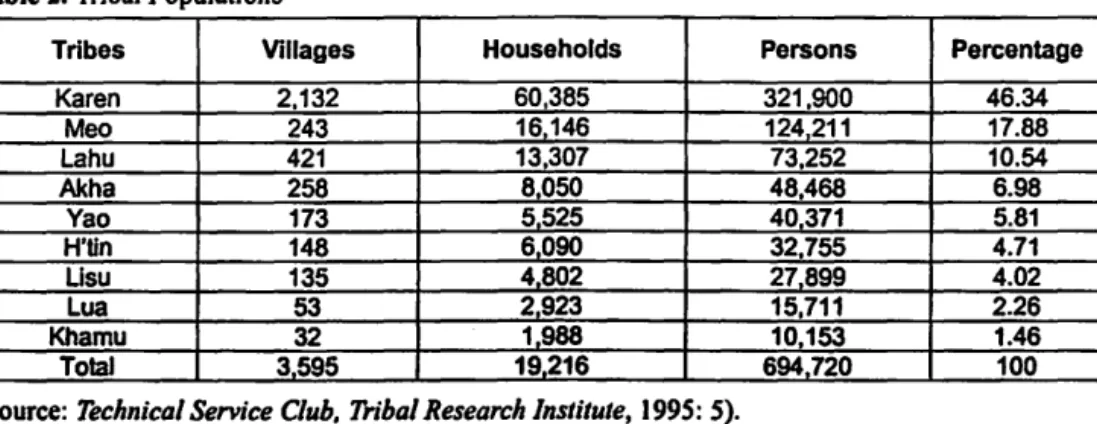Located among non-tribal communities, it is only a few kilometers from the center of Maluku Tengah district. Some believe that the Nuaulu's upheld traditional lifestyle and cultural beliefs are the reasons for the higher level. To answer these questions, demographic fieldwork was conducted in the village of Rouhua, as a representative of the Nuaulu community, and in Makariki, as a non-Nuaulu community, both in Maluku Tengah District.
The villagers have modern 'permanent' houses with toilets, which are completely different from the Nuaulu houses. It can be said that the livelihood of the inhabitants of Nuaulu is modest9• Sometimes they do not earn anything for months. Most women in Nuaulu never attended school, while in Makariki only 2.6% of the female population attended school (Appendix II).
In general, the educational level of Nuaulu women is lower than that of Makariki women. Most Nuaulu women give birth at a young age, younger than Makariki women. The family size of the Nuaulu population was found to be larger (5.98) than the Makariki population (4.3).
In fact, an underdeveloped tribal community exists even in reachable areas such as Nuaulu in Rouhua.
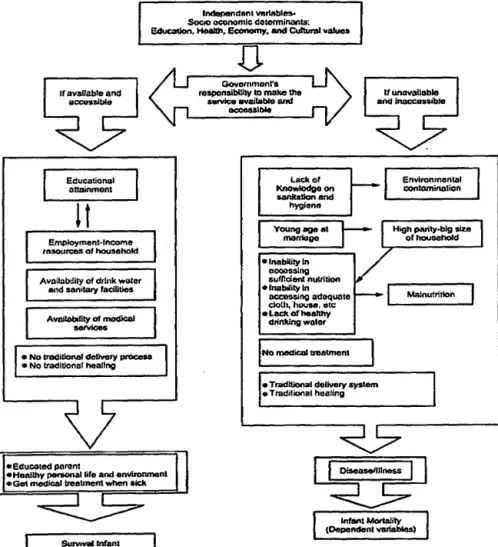
THE PROBLEMS OF INDONESIAN MIGRANT WORKERS' RIGHTS PROTECTION IN MALAYSIA 1
In this research, most of the randomly interviewed respondents were Indonesian migrant workers (TKI) with a few Filipinos, Indians and Vietnamese employed in various sectors such as domestic work, manufacturing, plantations, construction or retail (shops and cafes). The economic boom in Malaysia in the 1970s caused a massive demand for migrant workers from neighboring countries such as Indonesia, the Philippines and Thailand. Many Indonesian migrant workers have to endure various mistreatments and abuses from both their employers and recruitment agents.
This study found that the Malaysian government does not provide any legal protection program for migrant workers. This paper will examine common questions regarding the conditions of migrant workers' rights and the application of labor laws to migrant workers in Malaysia as a receiving country. We found that many employers preferred to employ undocumented migrant workers in their plantations in Bentong and Kuala Lipis in Pahang Darul Makmm.
The same practices occurred in Kuala Lumpur where many employers employed illegal migrant workers in the construction sectors. It has been revealed that many migrant workers are employed in plantations without adequate health and safety facilities in Bentong in Pahang state. Unhealthy working conditions are also experienced by many migrant workers in the rubber plantations in Kampung Sungai Penjuring and Kampung Lurah Bilut.
Many migrant workers work in the plantation sector in Kampung Sungai Penjuring, Kuala Lipis, and the Krau II Felda Plantation Sdn. In Kuala Lumpur we also found that many migrant workers employed in the construction sectors have not received their wages for 5 months. In Kuala Lipis and Bentong in the state of Pahang Darul Makmur, many Indonesian migrant workers (TKI) ran away from their employers due to very bad working conditions and underpayment.
The NGO's commitment is reflected in the MTUC Conference Resolution on Migrant Workers. As for the largest sending country, Indonesian representatives have some programs to protect Indonesian migrant workers in Malaysia. Migrant workers are very vulnerable to exploitation by their employers, recruitment agencies and government officials (police and immigration officials).
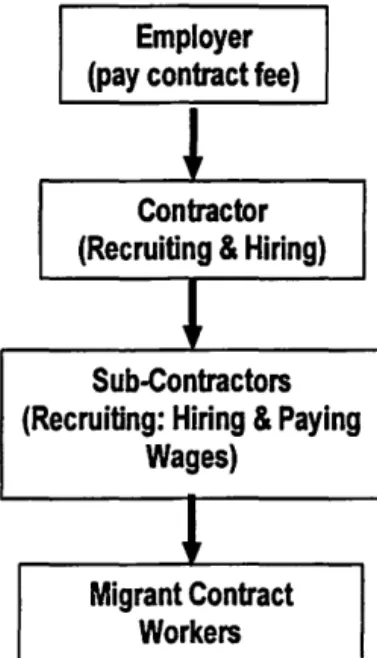
POPULATION MOBILITY AND TRADE CONTACTS IN THE GOLDEN TRIANGLE: THAILAND, MYANMAR AND
LAOS
Therefore, the Thai government tries to maintain a safe, conducive to progress and stability, situation in the border areas by developing the regions socially, culturally and economically. This study will hopefully contribute to the understanding of these complex matters in the border areas between Thailand and Myanmar and also be useful in understanding similar issues in Indonesia. Empirical research was carried out in the provinces of Chiang Mai, Chiang Rai, Nongkhai (Thailand) and in Savannhaket (Laos).
These ethnic minorities live mainly in the border areas between Burma and Thailand and in Tenasserin. The responsibilities of paying taxes and being subservient led to the Karen's suspicion of the Burmese government. The Burmese make up about 68% of the population of 45 million, but there are said to be more than 1,00 ethnic groups in the country.
The Akha settlement remained concentrated north of the Kok River in Chiang Rai province. As already stated, poppy-growing tribes began to settle in the Golden Triangle during the second half of the 19th century. In Burma, life has often been disrupted by ethnic conflicts, especially in the border areas and the country has always had the problem of disintegration.
Two networks are highly developed in the border areas between Thailand and Burma: the Keng-Tung-. The border between the two countries in Chiang Rai province has facilitated the movement of people and trade in the divided region. The flow of goods from China is clearly visible in the Chiang Rai market and the markets in the border areas of Laos.
In the past, the border areas between Thailand, Myanmar and Laos were developed with opium production, through which Thailand is said to provide 70% of the world's opium production. A subject from which we can learn a lot is the security aspect in the border areas between Thailand, Myanmar and Laos, where there is often instability and criminal activity. Migration, human trafficking and the sex industry in cross-border areas between Thailand and Burma".
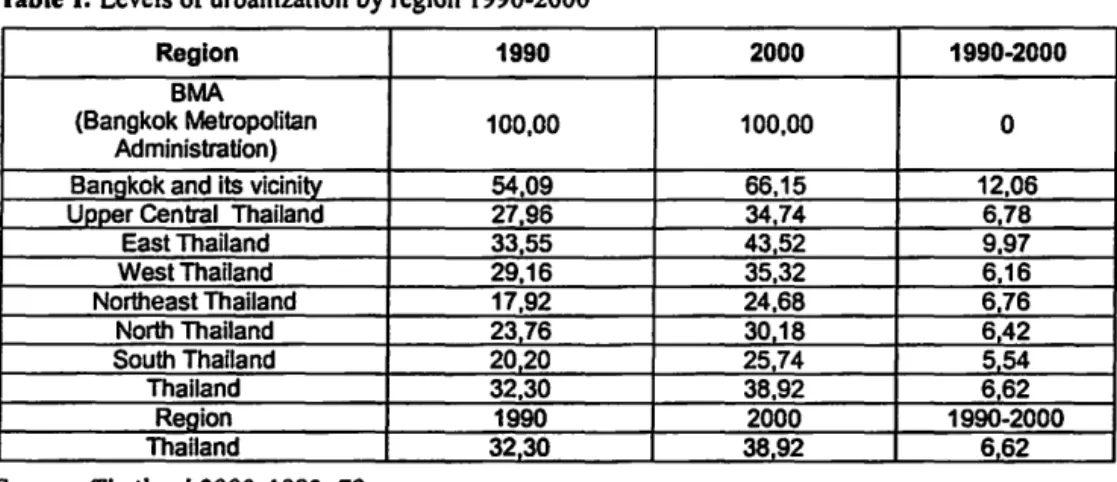
ADAPTASI PERTANIAN PENDUDUK DI KAWASAN KONSERVASI
Studi Tentang Perambahan Laban Kasus Tanaman Kulit Manis di Taman Nasional Kerinci Seblat, Jambi, Sumatera)
Namun luas areal budidaya kayu manis yang menjadi basis siklus budidaya tanaman sayuran terkait dengan pola penguasaan terhadap perkebunan kayu manis. Ini berarti bahwa sebagian besar (75,1%) petani responden tidak mengembangkan tanaman kayu manis atau sayuran siklus tetap. Kecenderungan ini memberikan kesan bahwa penguasaan lahan kayu manis tidak terkait dengan kecenderungan petani untuk mengembangkan lahan sayuran di areal penanaman kayu manis.
Peratusan responden mengikut pemilikan ladang dan aktiviti semasa membuka ladang sayur di kawasan ladang kulit manis. Ladang menetap biasanya dibangunkan oleh petani yang menguasai lebih daripada tiga bidang ladang tebu. Hak penggunaan tanpa had ke atas ladang tebu adalah berkaitan dengan kawalan ladang tebu.
Hak atas ladang kayu manis merupakan kenikmatan tak terbatas yang dapat diwariskan kepada keturunannya (Scholz. Seperti diketahui, kepemilikan atas ladang kayu manis dengan cara jual beli merupakan model penguasaan atas ladang kayu manis yang paling umum (Scholz. Kegiatan jual beli dan penjualan batang kayu manis yang terjadi di desa, tidak dapat didaftarkan di pemerintahan desa.
Tumbuhnya pola sewa lahan kayu manis ini didorong oleh para petani yang menginginkan lahan subur untuk ditanami sayuran. Penyewaan lahan kayu manis sebenarnya merupakan wujud dari terbatasnya penguasaan lahan yang memungkinkan berkembangnya siklus tanaman sayuran. Kebutuhan pengembangan lahan sayur sangat tergantung pada keberadaan tanaman kayu manis muda di sekitarnya.
Perkebunan kayu manis dapat dicampur (undercut) dengan tanaman berumur pendek (sayuran) yang menguntungkan dan dapat memenuhi kebutuhan sehari-hari. Sangat sedikit responden yang memiliki tiga atau lebih lahan kayu manis yang memiliki keragaman umur tanaman yang memungkinkan terjadinya siklus panen. Pola penguasaan tanah yang demikian berarti setiap orang bebas memiliki dan mengembangkan perkebunan kayu manis.
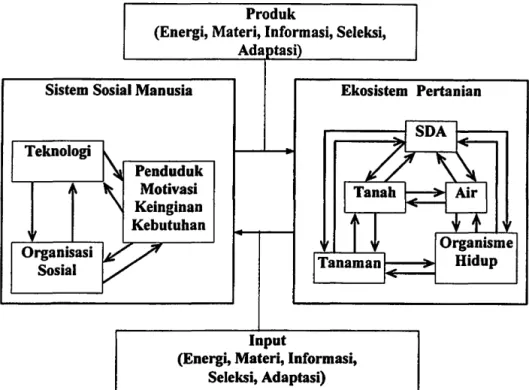
DAMPAK INVESTASI TERHADAP KETIMPANGAN KESEMPATAN KERJA REGIONAL DI INDONESIA
Oleh karena itu, investasi, pertumbuhan ekonomi, dan lapangan kerja merupakan tiga elemen yang saling terkait. Dalam metode input-output (tabel I/0), diketahui bagaimana peran induksi investasi di salah satu sektor utama dan dampaknya terhadap sektor lain, termasuk penyerapan tenaga kerja. Secara singkat kajian ini mencakup (i) Dinamika investasi PMDN dan FDI di wilayah KPI dan CTI, (ii) Situasi ketenagakerjaan di wilayah KPI dan CTI, dan (iii) Peran investasi dalam survei tenaga kerja di wilayah KBI dan CTI.
Secara umum, tinjauan fluktuasi investasi antar daerah di atas dapat menunjukkan sebaran geografis penyerapan tenaga kerja antar daerah. Keterkaitan antara investasi dan tenaga kerja dapat ditunjukkan melalui pembangunan industri di suatu wilayah tertentu. Artinya, tingkat penerimaan pegawai tetap di KBI lebih tinggi daripada di KTI.
Di dalam KBI sendiri, tingkat penyerapan tenaga kerja dengan status pekerjaan tetap relatif sama dengan di pulau Sumatera, Jawa dan Bali yaitu sekitar 25%. Dari ketiga wilayah tersebut, Pulau Bali menempati urutan pertama dengan tingkat penyerapan tenaga kerja sebesar 29,23%; kemudian diikuti serapan di Pulau Jawa sebesar 26,03% dan serapan di Pulau Sumatera sebesar 21,14%. Tingkat penyerapan tenaga kerja di provinsi ini hampir dua kali lipat dibandingkan provinsi lain secara keseluruhan.
Di sisi lain, terdapat kesamaan antara KBI dan KTI dalam hal jumlah tenaga kerja dengan status pemberi kerja. Selain itu, masalah penyerapan tenaga kerja tidak sepenuhnya bergantung pada kualitas tenaga kerja itu sendiri, tetapi ada faktor lain yang mempengaruhinya. Pertumbuhan ekonomi yang lebih besar akan meningkatkan lapangan kerja dan ini akan tercapai jika ada lebih banyak investasi.
Ada kecenderungan penerapan kenaikan upah minimum dalam skala yang cukup tinggi berdampak negatif terhadap peningkatan lapangan kerja. Hasil perhitungan korelasi statistik menunjukkan bahwa secara umum terjadi ketimpangan tenaga kerja di wilayah KBI dan KTI. Peran yang dimainkan oleh kualitas sumber daya manusia dalam kaitannya dengan penyerapan tenaga kerja sebagai pemberi kerja atau bisnis dengan karyawan tetap terlihat jelas melalui hasil korelasi antara investasi dan pekerja yang bekerja sebagai pemberi kerja.
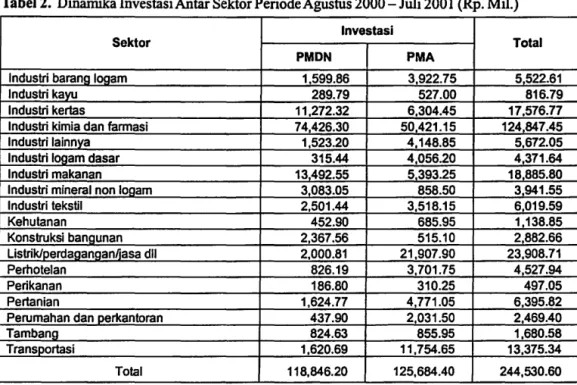
JURNAL KEPENDUDUKAN INDONESIA
KEPENDUDUKAN
INDONESIA
